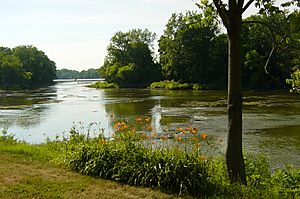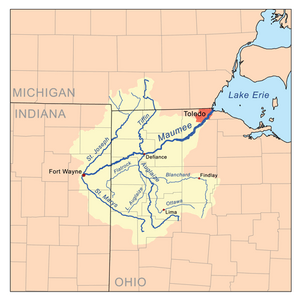Maumee River facts for kids
Quick facts for kids Maumee River |
|
|---|---|

The Maumee River at Grand Rapids, Ohio
|
|

Map of the Maumee River watershed
|
|
| Country | United States |
| States | Indiana, Ohio |
| Cities and towns | Fort Wayne, Indiana; New Haven, Indiana; Antwerp, Ohio; Cecil, Ohio; Defiance, Ohio; Florida, Ohio; Napoleon, Ohio; Grand Rapids, Ohio; Waterville, Ohio; Maumee, Ohio; Perrysburg, Ohio; Rossford, Ohio; Toledo, Ohio; Oregon, Ohio |
| Physical characteristics | |
| Main source | Fort Wayne by the confluence of the St. Joseph and St. Marys 750 ft (230 m) 41°04′58″N 85°07′56″W / 41.0827778°N 85.1322222°W |
| River mouth | Lake Erie at Toledo 571 ft (174 m) 41°41′58″N 83°27′36″W / 41.6994444°N 83.46°W |
| Length | 137 miles (220 km) |
| Basin features | |
| Progression | Northeast |
| Basin size | 6,354 sq mi (16,460 km2) |
The Maumee River is an important river in the United States. It flows from northeastern Indiana into northwestern Ohio. Finally, it empties into Lake Erie. The big city of Toledo is right where the Maumee River meets Lake Erie.
This river is special because it has the largest watershed of any river that flows into the Great Lakes. A watershed is all the land area where water drains into a specific river. The Maumee River provides about five percent of the water that goes into Lake Erie.
Contents
Where the Maumee River Flows
The Maumee River starts in Fort Wayne, Indiana. This is where two smaller rivers, the St. Joseph River and the St. Marys River, join together. From Fort Wayne, the Maumee River flows northeast. It travels about 137 miles (220 kilometers) through parts of Indiana and Ohio.
Journey to Lake Erie
As the river moves through Ohio, it passes by several towns and cities. These include Defiance, Ohio, Napoleon, Ohio, and Perrysburg, Ohio. The river's journey ends when it flows into Lake Erie at Toledo. This makes Toledo an important port city.
Why the Maumee River is Important
The Maumee River has been very important for people for a long time. Native American tribes like the Shawnee and Miami lived along its banks. They used the river for travel, fishing, and trade. The river's name comes from the Miami-Illinois language.
Historical Significance
In the past, the Maumee River was a key route for transportation. It helped early settlers move goods and people. The river's path also played a role in historical events. For example, the Battle of Fallen Timbers in 1794 happened near the river. This battle was a big moment in the history of the Northwest Territory.
Modern Uses
Today, the Maumee River is still very useful. It provides water for farms and industries. People also use the river for fun activities like fishing, boating, and kayaking. Many parks and nature areas are found along its banks. These places offer great spots for outdoor adventures.
Water Quality
Because the Maumee River flows through a lot of farmland, it can carry nutrients like phosphorus into Lake Erie. This can sometimes cause algal blooms in the lake. Scientists and local groups are working hard to keep the river and Lake Erie clean and healthy for everyone.
Wildlife and Nature
The Maumee River and its surrounding areas are home to many different kinds of plants and animals. The river supports various fish species. These include walleye, smallmouth bass, and catfish. Many birds also live near the river, such as bald eagles and great blue herons.
The Great Black Swamp
Before it was settled, much of the land around the Maumee River was part of a huge wetland called the Great Black Swamp. This swamp was full of thick forests and wet areas. It was a challenging place to travel through. Over time, most of the swamp was drained for farming. However, efforts are now being made to restore some of these important wetland habitats. These habitats help filter water and provide homes for wildlife.
Images for kids
-
The Veterans' Glass City Skyway in Toledo, Ohio
See also
 In Spanish: Río Maumee para niños
In Spanish: Río Maumee para niños









